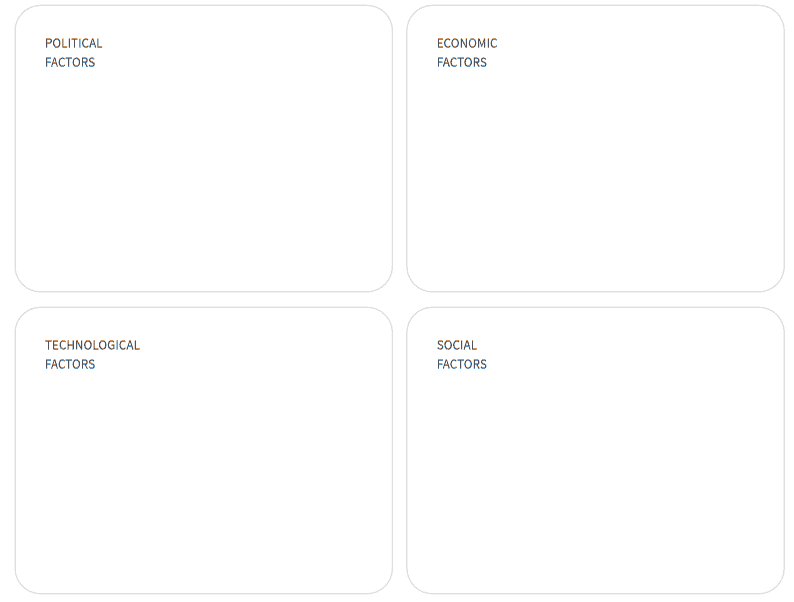PEST Analysis Introduction

The name “PEST Analysis” is based on the first letters of the factors Politics, Economy, Social and Technology. It is a business, strategic and analytical model that is used to identify opportunities and threats in the market on the basis of external Political, Economic, Social and Technological developments with the aim of generating impact for the company.
In order to identify new developments, society must be clearly scanned at the macro level. In order to create that overview, the developments must be categorized under the letters P-E-S-T. The PEST Analysis helps in gathering information to make strategic planning, allocate budget and conduct market research.
In addition to political, economic, social and technological developments, it is also possible to investigate other developments in society, such as Demography, Environment, Ecology, Ethical and Legal. Many letter combinations are possible on the basis of the factors that are relevant to the company. Other variations of the PEST Analysis are the DESTEP, PESTLE, ELSA and STEEPLED.

The PEST Analysis is often used in combination with other analytical tools, such as the SWOT analysis and Porter’s Five Forces, to identify the best possible picture of opportunities and threats. The PEST Analysis was originally designed as a business environment scan.
Template
Download Template
PEST Analysis / PESTLE AnalysisOnline Templates
Executing the Method
-
Step 1: Determine factors
Brainstorm with the team about the different factors and determine which factors affect the business and which ones need to be investigated.
-
Step 2: Using the Template
Print out the template with the table, draw it digitally or on a large sheet of paper or flip chart.
-
Step 3: Collect information
Investigate for each chosen factor what developments are going on and map out the changes taking place in the environment of the company. Then collect all relevant information, in a group or individually. Do this by describing them in 1 or 2 terms on post-its.
-
Step 4: Brainstorming
Start brainstorming. Every change, development and opportunity is examined, after which the question is asked what possibilities this offers the company. Write this on the accompanying post-its and place it with the correct factor. (Use "PEST Questions" to identify opportunities).
-
Step 5: Identify threats
The identified developments, changes and opportunities can also pose a threat to the company. Think about the way in which these can be threatening and write this in 1 or 2 terms on post-its under the corresponding factor. Identifying them early prevents any problems. (Use "PEST Questions" for that).
-
Step 6: Organize
Arrange all post-its with their developments, opportunities and threats based on the expected impact on the company.
-
Step 7: Determine further strategy
Convert all possible opportunities into actions that can be taken and incorporate these actions into the business plan and/or strategy.
Necessities
PEST Questions:
Advantages & Disadvantages
-
The environmental influences of the company are mapped, so that the company generates more knowledge of the environment. The PEST Analysis is also very useful, because it contributes to creating opportunities.
-
Because the developments are signaled at the macro level, there is a lack of international developments that can offer insights into opportunities and threats. Therefore, in some cases the letter I of international influences is added. This is interesting for companies that operate internationally.


